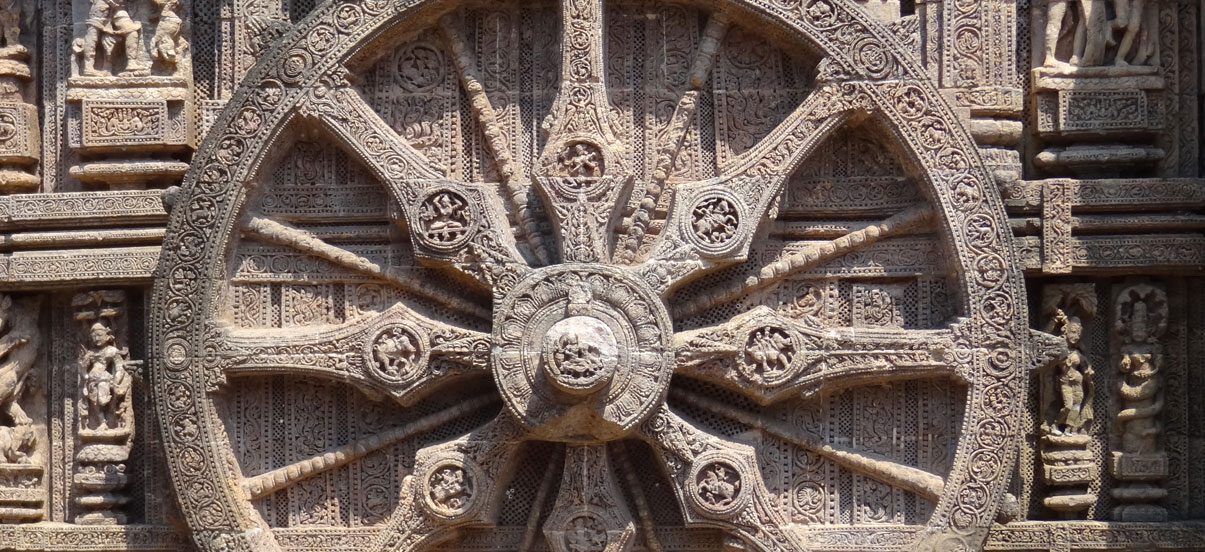Lord of the Universe is lord Jagannatha . The temple is at Puri . This is one of the most sacred pilgrimage spots in India. One of the four abodes or dhamas of the divine that lie on the four directions of the compass. The present temple structure was built in the twelfth century by the Ganga king, Chodaganga deva, replacing an earlier structure which probably dated to the tenth century.
Before one reaches at Puri, spire of the temple can be seen towering over the countryside. The temple built on an elevated ground about twenty feet above the level of the surrounding area . The height of the main temple is 214.8 feet. And it is fine specimen of the Pancharath style of Odishan architecture. The main shrine consists of four distinct structures . One is Vimana or the great temple. Second is Jagamohan or the hall of audience.Third is Natamandap or the dancing hall and fourth is Bhogamandap or the refractory. The huge temple compound, each side of which measures 650 feet (some 200 meters), is surmounted with a 20 foot (6 meters) wall. Within the compound is a city, or more accurately, a universe unto itself. With 6000 direct temple servitors, a temple kitchen which feeds 10,000 people daily (and some 25,000 on festival days), and a central deity who has become the focus of religious life throughout Odisha, the Jagannath temple is truly an institution unique in the world.
The image of lord Jagannath, lord Balabhadra and devi Subhadra and also the emblem Sudarshan are installed in the inner sanctrum of the temple on a platform is called Ratnavedi or jeweled platform. The miniature image of devi Laxmi, Saraswti and Madhava are also placed on the Ratnavedi . This platform is made of a single stone which is about 16ft long, 13ft wide and 4ft height. The temple has four gates at the eastern, southern, western and nothern. They are known as Singhadwar, Ashwadwar, Vyaghradwar and Hastidwar.
Just infront of the Singhadwar, a pillar is installed is known as Arunastambha. It is made of a single chlorite stone. Historical documents say that this pillar was installed previously infront of the Sun Temple konark. After the Sun Temple collapsed , the Marahattas brought it to puri and placed it before the Lion gate. The height of this pillar or Stambha is 33ft and 8 inches.
Almost the entire temple was covered in white plaster, so much so that European sailors in previous centuries used it as a navigation point, referring to it as the ‘white pagoda’ (in contrast to the ‘black pagoda’ of Konark). However, were long puzzled by the plain facade on this holiest of holy temples, and wondered why it was untouched by Odisha’s rich sculptural heritage. The answer was found in 1975, when archaeologists first began removing the plaster, and found that the sculpture underneath indeed rivals that of the other masterpieces of Odishan temple art. The best guess as to the reason for applying the plaster originally is that an eighteenth century ruler decided that this would be a way to protect the temple from the ravages of the salty sea air. Succeeding rulers continued the practice. As the old plaster is being removed, archaeologists are also repairing the corroded iron dowels in the original structure, and replacing broken stones with new ones. Finally, a clear, thin coating is being applied to the entire structure, to preserve it for the centuries to come.
There are several places to see inside or outside this temple are Asta Sambhu or Asta Chandi, Pancha Tirtha, Narshingha temple, Vimala Temple, Lakshmi Temple, Surya temple, Mukti Mandap, Kalpa Bata, Rohini Kunda, Baisi Pahacha( twenty two stairs), The temple kitchen, Anand Bazar, SnahaBedi and also Koili Baikuntha.
Entrance is forbidden to non-Hindus, because of the temple’s intense religious importance and hallowed traditions . To have a good view of the temple and its compound, visitors are welcome to ascend to the roof of the Raghunandan Library which is across the street. In the bazaar area surrounding the temple, dozens of shops display and sell image of the central temple deity, Lord Jagannath, presented in a trinity with his ‘brother’ Balbhadra and his ‘sister’ Subhadra. The pervasive quality of the Jagannath cult will be seen when travelling in other parts of Orissa, where the distinctive image of Jagannath appears with great frequency. Even to the non-religious eye, the image is fascinating, perhaps because of the unlikely combination of the endearing, charming form with an undeniable sense of power.
Even the non-Hindu visitor to Puri will feel some of the power of this throbbing pilgrimage center. The bazaar streets immediately surrounding the temple are filled with activity and bustle, but it is all infused with a palpable sense of gentleness and good spirit. Walk around the bazaar in the early evenings just as the lights are coming on. Look up to the magnificent tower of Jagannath towering over everything, surmounted by the flag of Vishnu flying in the breeze. Gaze at the faces of the pilgrims entering or leaving the temple, inhale the scents of incense mixed with the tantalizing sizzles of frying sweets and snacks. And just let your feet take you where they may. Even the most secular-minded of visitors are bound to feel that they, too, have embarked on a kind of pilgrimage to a uniquely special place.
1











